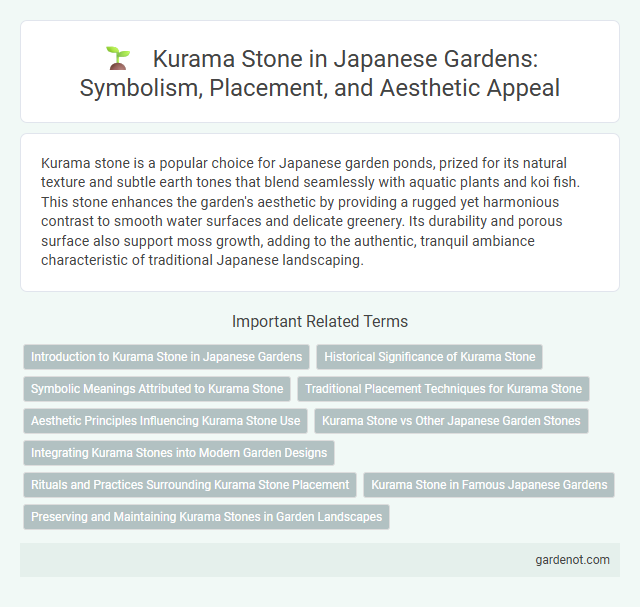Kurama stone is a popular choice for Japanese garden ponds, prized for its natural texture and subtle earth tones that blend seamlessly with aquatic plants and koi fish. This stone enhances the garden's aesthetic by providing a rugged yet harmonious contrast to smooth water surfaces and delicate greenery. Its durability and porous surface also support moss growth, adding to the authentic, tranquil ambiance characteristic of traditional Japanese landscaping.
Introduction to Kurama Stone in Japanese Gardens
Kurama stone, sourced from the Kurama region near Kyoto, is highly valued in Japanese gardens for its rugged texture and natural, earthy tones that evoke a sense of tranquility. It plays a central role in creating authentic landscape aesthetics by representing mountains or islands, enhancing the garden's spiritual and visual harmony. Its durability and unique appearance make it an essential element in traditional rock arrangements and garden pathways.
Historical Significance of Kurama Stone
Kurama Stone holds deep historical significance as it originates from the Kurama region, known for its sacred mountains and ancient temples in Kyoto, Japan. Traditionally used in Japanese gardens, Kurama Stone symbolizes strength and spiritual connection, reflecting centuries-old cultural practices. Its unique texture and weathered appearance represent the harmony between natural elements and human craftsmanship in Japanese garden design.
Symbolic Meanings Attributed to Kurama Stone
Kurama stone in Japanese gardens symbolizes strength, stability, and spiritual protection, often representing the enduring power of nature. Its use reflects the connection between the physical garden and the sacred mountains of Kurama, evoking a sense of tranquility and resilience. Garden designers incorporate Kurama stone to embody harmony and the balance between human and natural elements.
Traditional Placement Techniques for Kurama Stone
Kurama stone placement in Japanese gardens follows traditional techniques emphasizing balance and natural harmony, carefully positioning each stone to replicate nature's organic formations. The stones are often placed in asymmetrical arrangements, adhering to principles of wabi-sabi and shakkei, to create a sense of depth and tranquility. Master gardeners select Kurama stones for their unique angular shapes and textures, ensuring each stone enhances the garden's visual rhythm and spiritual ambiance.
Aesthetic Principles Influencing Kurama Stone Use
Kurama stones embody the Japanese aesthetic principles of wabi-sabi, emphasizing natural simplicity and imperfection to create a sense of harmony within the garden. Their rugged texture and irregular shapes contribute to the garden's visual balance, reflecting the concept of shakkei, or borrowed scenery, by seamlessly integrating with surrounding natural elements. Placement of Kurama stones follows the principle of ma, the thoughtful use of space, enhancing the garden's tranquil and contemplative atmosphere.
Kurama Stone vs Other Japanese Garden Stones
Kurama stone, sourced from Kyoto's Kurama region, is prized for its rough texture and natural variation, setting it apart from smoother Japanese garden stones like granite and basalt. Its unique gray-green color with rugged crevices adds a rustic, aged aesthetic essential for authentic dry rock gardens and pathways. Compared to polished stones, Kurama stone enhances the garden's organic feel, blending seamlessly with moss and water features for a balanced natural landscape.
Integrating Kurama Stones into Modern Garden Designs
Kurama stones, renowned for their rugged texture and natural aesthetic, serve as focal points in modern Japanese garden designs by enhancing spatial harmony and visual depth. These iconic stones, sourced from the Kurama region north of Kyoto, are prized for their moss-friendly surface and weathered appearance, which blend seamlessly with contemporary landscaping elements like minimalist pathways and water features. Incorporating Kurama stones supports sustainable garden practices by using natural materials that age gracefully, fostering a serene atmosphere that connects traditional Japanese garden philosophy with modern outdoor living spaces.
Rituals and Practices Surrounding Kurama Stone Placement
Kurama stone placement in Japanese gardens follows precise rituals rooted in Shinto beliefs, emphasizing harmony with nature and spiritual balance. Gardeners ceremoniously position Kurama stones to channel positive energy and create sacred spaces, often aligning them with cardinal directions based on traditional geomancy. These practices enhance the garden's tranquility, inviting meditation and a profound connection to the natural and spiritual worlds.
Kurama Stone in Famous Japanese Gardens
Kurama Stone, known for its distinctive dark gray texture and natural ruggedness, is prominently featured in famous Japanese gardens such as Ryoan-ji in Kyoto. Its robust, weathered appearance symbolizes strength and stability, enhancing the meditative atmosphere of Zen gardens. The stone's unique mineral composition and historical significance contribute to its revered status in traditional Japanese landscaping.
Preserving and Maintaining Kurama Stones in Garden Landscapes
Preserving Kurama stones in garden landscapes requires careful cleaning with soft brushes and water to maintain their natural texture without damaging the stone. Regular inspection for moss growth and weathering ensures these iconic stones retain their aesthetic and cultural significance. Applying protective sealing treatments can extend the lifespan of Kurama stones while preserving their traditional appearance.
Kurama stone Infographic

 gardenot.com
gardenot.com